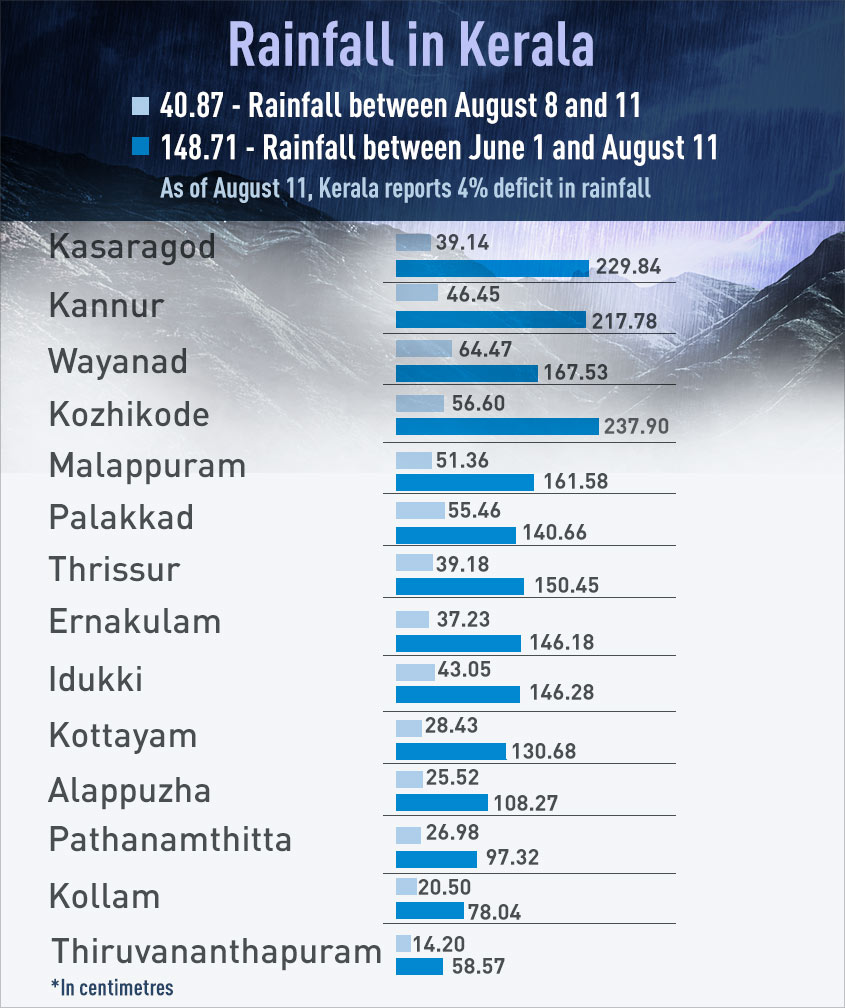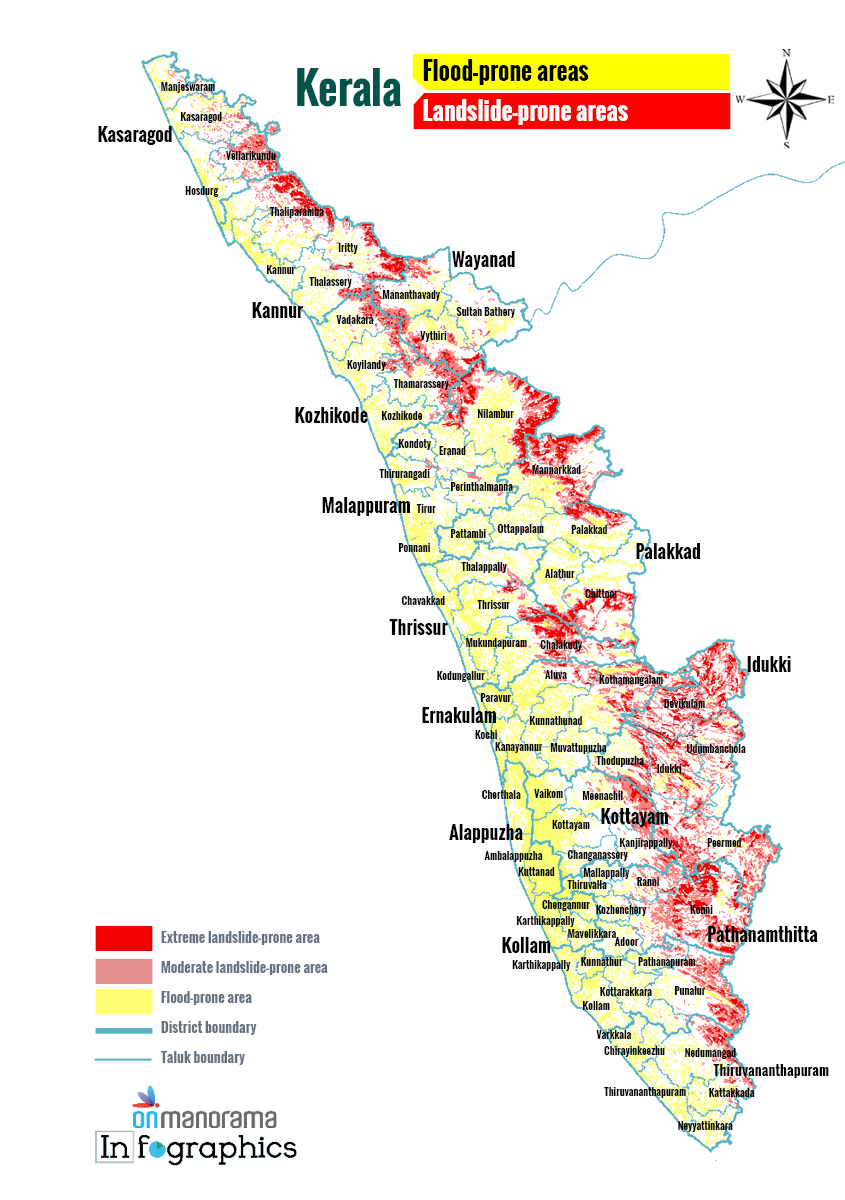Worst choreographed monsoon buries Kerala under tonnes of boulders and mud

Mail This Article
If there are higher beings who can have a detached view of what's happening on the planet, they would have had a throaty laugh at the messy choreography of southwest monsoon this season in Kerala.
Like never before, the monsoon's performance was wildly out of sync. Imagine a dance musical made up of dancers with the timing of a tail-end batsman and musicians with a talent-wish mismatch wider than even the deeds and words of politicians. And what if these amateurs had not a second to rehearse. The monsoon's performance this season was far more chaotic.
Yet, amusingly, official meteorological figures indicate that monsoon would be 'normal' in Kerala. This is but a 'paper normal', seen only in IMD charts, but achieved in perhaps the most clumsily dangerous manner possible. Never before in the past 30 years has a monsoon deficit of over 50 per cent accumulated during June and July been made up in just a handful of days in August. The extended stretch of lazy movements was made up by a clumsy outburst of hyper performance towards the fag end.
Promising start
The monsoon, though late to touch base, began reasonably well. When June 10 and 11 saw heavy rain, with daily rainfall shooting far above the normal and touching a prosperous 40 millimetre, there were visions of a healthy monsoon. Suddenly there came a lull. But this was normal. The southwest monsoon is characterised by active-break cycles; a glorious chorus that goes up and down in a rhythmic way.
So the lull was seen as the first break cycle of the season. And true to style, the active cycle resumed with rain picking up by June 18 and the season's rainfall achieving another mini-peak on June 22. Once again there was a lull. The second break cycle, it was reasoned. But this break cycle extended for a considerably more time than was usual. By the first week of July, the deficit grew to 35 per cent.
Spectre of drought
An abnormally long break cycle, like a long active cycle, is ominous. Last year there was no break cycle, just a long unbroken active cycle, and the result was the most devastating floods in Kerala's history. An indefinitely long break period meant the opposite: drought.
With the summer rainfall too short by over 35 per cent, a severe drought was a distinct possibility. In fact, there was rainfall for just six days in July. By the start of August, the monsoon deficit was nearly 50 per cent. This was thought unbridgeable. To compound worries, storage level in the state's dams plummeted to 10 per cent.
Thunder and weak winds
Some abnormalities were detected by then. Thunder and lightning were frequently reported from various parts of the state during June and July. The southwest monsoon is largely devoid of fireworks, unlike the northeast season. This indicated that this year's monsoon was highly localised. "Monsoon is not continuous this time, and that was why lightnings were frequently reported. And nowhere in the state had it rained for more than half an hour at a stretch during June and July," said Manoj, a weather researcher in CUSAT, Kochi.
The wind speed was also recorded to be slow during the first two months. Usually, the wind speed during a monsoon touches 40-60 km per hour. IMD figures showed that during June and July the speed has not crossed 30 km per hour. Meaning, the rate of transfer of moisture from the Indian Ocean and Arabian Sea has fallen. Lower the speed, weaker the transfer of moisture. Between July 25 and August 5, there was virtually no rain across the state. It looked like a lost cause. A drought was imminent.

Vengeful return
From August 6, the monsoon returned but with a scary vigour. And on August 8, all hell broke loose. The day had historically received just 1.5 cm of rain but this year 14 cm was received across the state. Nilambur was smothered by 39.8 cm of rain on the day, a 50-year record. An IMD source said Kavalappara near Nilambur, where a landslide claimed scores of lives, had never received such torrential rainfall in the last 300 years.
Between August 5 and August 10, Wayanad received 76.7 cm rainfall, an amount the district does not normally receive even during the whole of August. The worst affected northern districts – Wayanad, Malappuram, Kozhikode and Palakkad – witnessed an abnormally steep increase in rainfall. These districts saw a 60-80 per cent hike in rainfall in four to five days.

Boulder drops
More abnormalities came to light. The drop size (size of a rain droplet) of the monsoon rain was considerably larger than normal. "The monsoon cloud was found to be far more thicker," said Manoj. Usually monsoon clouds are horizontally long but vertically slim.
"The thickness will not be more than 4-5 kilometres," Manoj said. This time the thickness was nearly double, mimicking the size of northeast monsoon clouds. The IMD source said this also explained the large drop size, and also the frequent thunder and lightning.
"Thicker clouds and large drop size will result in high intensity rainfall," the IMD source said. There is also a suspicion that it could have been a cloudburst that devastated Kavalappara and Puthumala.
Was it cloudburst?
It is called a cloudburst when 10 cm or more rain falls upon a particular area within an hour. The IMD figures show that Puthumala alone had received 48.70 cm of rainfall in four days. But whether this involved a bout of cloudburst, the IMD has no idea. It does not have the instruments to check such a phenomenon.
If it was indeed a cloudburst, then it would be yet another first for Kerala. Never before has cloudburst been reported in the state.




